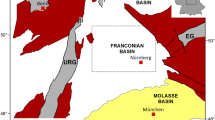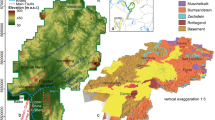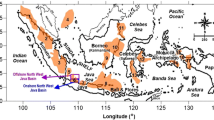Abstract
With this paper, we assess the present-day conductive thermal field of the Glueckstadt Graben in NW Germany that is characterized by large salt walls and diapirs structuring the graben fill. We use a finite element method to calculate the 3D steady-state conductive thermal field based on a lithosphere-scale 3D structural model that resolves the first-order structural characteristics of the graben and its underlying lithosphere. Model predictions are validated against measured temperatures in six deep wells. Our investigations show that the interaction of thickness distributions and thermal rock properties of the different geological layers is of major importance for the distribution of temperatures in the deep subsurface of the Glueckstadt Graben. However, the local temperatures may result from the superposed effects of different controlling factors. Especially, the upper sedimentary part of the model exhibits huge lateral temperature variations, which correlate spatially with the shape of the thermally highly conductive Permian salt layer. Variations in thickness and geometry of the salt cause two major effects, which provoke considerable lateral temperature variations for a given depth. (1) The “chimney effect” causes more efficient heat transport within salt diapirs. As a consequence positive thermal anomalies develop in the upper part and above salt structures, where the latter are covered by much less conductive sediments. In contrast, negative thermal anomalies are noticeable underneath salt structures. (2) The “thermal blanketing effect” is caused by thermally low conductive sediments that provoke the local storage of heat where these insulating sediments are present. The latter effect leads to both local and regional thermal anomalies. Locally, this translates to higher temperatures where salt margin synclines are filled with thick insulating clastic sediments. For the regional anomalies the cumulative insulating effects of the entire sediment fill results in a long-wavelength variation of temperatures in response to heat refraction effects caused by the contrast between insulating sediments and highly conductive crystalline crust. Finally, the longest wavelength of temperature variations is caused by the depth position of the isothermal lithosphere–asthenosphere boundary defining the regional variations of the overall geothermal gradient. We find that a conductive thermal model predicts observed temperatures reasonably well for five of the six available wells, whereas the steady-state conductive approach appears not to be valid for the sixth well.












Similar content being viewed by others
References
Baldschuhn R, Frisch U, Kockel F (1996) Geotektonischer Atlas von NW-Deutschland 1:300,000. 65 maps, Bundesanstalt für Geowissenschaften und Rohstoffe, Hannover, p. 4
Baldschuhn R, Binot F, Fleig S, Kockel F (2001) Geotektonischer Atlas von Nordwest—Deutschland und dem deutschen Nordsee-Sektor, Reihe A, Heft 153, Geologisches Jahrbuch
Bayer U, Scheck M, Koehler M (1997) Modeling of the 3D thermal field in the northeast German basin. Geol Rundsch 86:241–251. doi:10.1007/s005310050137
Bayer U, Grad M, Pharaoh TC, Thybo H, Guterch A, Banka D, Lamarche J, Lassen A, Lewerenz B, Scheck M, Marotta AM (2002) The southern margin of the East European Craton: new results from seismic sounding and potential fields between the North Sea and Poland. Tectonophysics 360(1–4):301–314. doi:10.1016/S0040-1951(02)00359-1
Benek R, Kramer W, McCann T, Scheck M, Negendank J, Korich D, Huebscher H-D, Bayer U (1996) Permo-Carboniferous magmatism of the Northeast German Basin. Tectonophysics 266(1–4):379–404. doi:10.1016/S0040-1951(96)00199-0
Best G, Kockel F, Schoeneich H (1983) Geological history of the southern Horn graben. Geol Mijnbouw 62:25–33. doi:10.1007/978-94-009-5532-5_2
Brink H, Franke D, Hoffmann N, Horst W, Oncken O (1990) Structure and evolution of the North German Basin. In: Freeman R, Giese P, Mueller S (eds) The European Geotraverse: integrative studies. European Sciences Foundation, Strasbourg, pp 195–212
Brink H, Dürschner H, Trappe H (1992) Some aspects of the late and post-Variscan development of the Northwestern German Basin. Tectonophysics 207(1–2):65–95. doi:10.1016/S0040-1951(02)00359-1
Cacace M, Scheck-Wenderth M (2010) Modeling the thermal field and the impact of salt structures in the North East German Basin. In: Proceedings World Geothermal Congress
Čermák V, Rybach L (1982) Thermal conductivity and specific heat of minerals and rocks. In: Angenheister G (ed) Landolt-Börnstein; Zahlenwerte und Funktionen aus Naturwissenschaften und Technik. (Hrsg.): Bd. 1, Physikalische Eigenschaften der Gesteine, Teilbd. a., Springer-Verlag Berlin, Heidelberg, New York, pp 305–343
Cherubini Y, Cacace M, Scheck-Wenderoth M, Moeck I, Lewerenz B (2013) Controls on the deep thermal field—implications from 3D numerical simulations for the geothermal research site Groß Schönebeck. Environ Earth Sci. doi:10.1007/s12665-013-2519-4
Dohr G, Bachmann G, Grosse S (1989) Das Norddeutsche Becken. Veröffentlichungen-Niedersächsische Akademie der Geowissenschaften 2:4–47
Eaton DW, Darbyshire F, Evans RL, Grütter H, Jones AG, Yuan X (2009) The elusive lithosphere–asthenosphere boundary (LAB) beneath cratons. Lithos 109(1):1–22. doi:10.1016/j.lithos.2008.05.009
Jaritz W (1969) Epiorogenese in Nordwestdeutschland im höheren Jura und in der Unterkreide. Geologische Rundschau 59(1 Taf.):114–124
Jaritz W (1980) Einige Aspekte der Entwicklungsgeschichte der nordwestdeutschen Salzstöcke. Zeitschrift der Deutschen Geologischen Gesellschaft 131:387–408
Kaiser BO, Cacace M, Scheck-Wenderoth M, Lewerenz B (2011) Characterization of main heat transport processes in the Northeast German Basin: Constraints from 3-D numerical models. Geochem Geophys Geosyst 12:Q07011. doi:10.1029/2011GC003535
Kockel F (2002) Rifting processes in NW-Germany and the German North Sea Sector. Geol Mijnbouw 81:149–158
Kühn M, Günther A (2007) Stratabound Rayleigh convection observed in a 4D hydrothermal reactive transport model based on the regional geological evolution of Allermöhe (Germany). Geofluids 7(3):301–312. doi:10.1111/j.1468-8123.2007.00182.x
Kukkonen I, Jokinen J, Seipold U (1999) Temperature and pressure dependencies of thermal transport properties of rocks: implications for uncertainties in thermal lithosphere models and new laboratory measurements of high-grade rocks in the central Fennoscandian shield. Surv Geophys 20(1):59. doi:10.1023/A:1006655023894
Kus J, Cramer B, Kockel F (2005) Effects of a Cretaceous structural inversion and a postulated high heat flow event on petroleum system of the western Lower Saxony Basin and the charge history of the Apeldorn gas field. Neth J Geosci: Geologie en Mijnbouw 84:3–24
Landolt-Börnstein (1960) Zahlenwerte und Funktionen. 6. Auflage, II. Band, Eigenschaften der Materie in ihren Aggregatzuständen. 7. Teil, Elektrische Eigenschaften II (Elektrochemische Systeme) Springer-Verlag, Berlin-Göttingen-Heidelberg 1960. 959 Seiten, Zeitschrift für Elektrochemie, Berichte der Bunsengesellschaft für physikalische Chemie 66(1):74–74
Maystrenko Y, Scheck-Wenderoth M (2009) Density contrasts in the upper mantle and lower crust across the continent–ocean transition: constraints from 3-D gravity modelling at the Norwegian margin. Geophys J Int 179:1. doi:10.1111/j.1365-246X.2009.04273.x
Maystrenko YP, Scheck-Wenderoth M (2013) 3D lithosphere-scale density model of the Central European Basin system and adjacent areas. Tectonophysics. doi:10.1016/j.tecto.2013.04.023
Maystrenko Y, Bayer U, Scheck-Wenderoth M (2005a) The Glueckstadt Graben, a sedimentary record between the North and Baltic Sea in north Central Europe. Tectonophysics 397(1–2):113–126. doi:10.1016/j.tecto.2004.10.004
Maystrenko Y, Bayer U, Scheck-Wenderoth M (2005b) Structure and evolution of the Glueckstadt Graben due to salt movements. Int J Earth Sci 6:799–814. doi:10.1007/s00531-005-0003-4
Maystrenko Y, Bayer U, Scheck-Wenderoth M (2006) 3D reconstruction of salt movements within the deepest post-Permian structure of the Central European Basin system—the Glueckstadt Graben. Neth J Geosci: Geologie en Mijnbouw 85(3):181–196
Maystrenko YP, Bayer U, Scheck-Wenderoth M (2013) Salt as a 3D element in structural modelling—example from the Central European Basin system. Tectonophysics 591:62–82. doi:10.1016/j.tecto.2012.06.030
Noack V, Cherubini Y, Scheck-Wenderoth M, Lewerenz B, Höding T, Simon A, Moeck I (2010) Assessment of the present-day thermal field (NE German Basin)—inferences from 3D modelling. Chem Erde 70(Suppl 3):47–62. doi:10.1016/j.chemer.2010.05.008
Noack V, Scheck-Wenderoth M, Cacace M (2012) Sensitivity of 3D thermal models to the choice of boundary conditions and thermal properties: a case study for the area of Brandenburg (NE German Basin). Environ Earth Sci 67(6):1695–1711. doi:10.1007/s12665-012-1614-2
Noack V, Scheck-Wenderoth M, Cacace M, Schneider M (2013) Influence of fluid flow on the regional thermal field: results from 3D numerical modelling for the area of Brandenburg (North German Basin). Environ Earth Sci. doi:10.1007/s12665-013-2438-4 (in press)
Norden B, Förster A, Balling N (2008) Heat flow and lithospheric thermal regime in the Northeast German Basin. Tectonophysics 460:215–229. doi:10.1016/j.tecto.2008.08.022
Norden B, Förster A, Behrends K, Krause K, Stecken L, Meyer R (2012) Geological 3-D model of the larger Altensalzwedel area, Germany, for temperature prognosis and reservoir simulation. Environ Earth Sci 67:511–526. doi:10.1007/s12665-012-1709-9
Ondrak R, Wenderoth F, Scheck M, Bayer U (1998) Integrated geothermal modeling on different scales in the Northeast German basin. Geol Rundsch 87(1):32–42. doi:10.1007/s005310050187
Pester S, Agemar T, Alten J-A, Kuder J, Kuehne K, Maul A–A, Schulz R (2010) GeotIS—the geothermal information system for Germany. In: Proceedings World Geothermal Congress, pp 25–29
Rodon S, Littke R (2005) Thermal maturity in the Central European Basin system (Schleswig-Holstein area): results of 1D basin modelling and new maturity maps. Int J Earth Sci 94(5):815–833. doi:10.1007/s00531-005-0006-1
Sannemann D (1965) Salt-Stock Families in Northwestern Germany. AAPG Bull 49:357
Sannemann D (1968) Salt-stock families in Northwestern Germany. In: Braunstein J, O’Brien G (eds) Diapirism and diapirs. AAPG publication, Tulsa, pp 261–270
Scheck M (1997) Dreidimensionale Strukturmodellierung des Nordostdeutschen Beckens unter Einbeziehung von Krustenmodellen. Technical Report, Geo Forschungs Zentrum Potsdam
Scheck-Wenderoth M, Maystrenko Y (2008) How warm are passive continental margins? A 3-D lithosphere-scale study from the Norwegian margin. Geology 36:419–422
Schöner R (2006) Comparison of Rotliegend sandstone diagenesis from the northern and southern margin of theNorth German Basin, and implications for the importance of organic maturation and migration. PhD thesis University, Jena
Thybo H (2001) Crustal structure along the EGT profile across the Tornquist Fan interpreted from seismic, gravity and magnetic data. Tectonophysics 334(3):155–190. doi:10.1016/S0040-1951(01)00055-5
Trusheim F (1960) Mechanism of salt migration in northern Germany. Assoc Petrol Geol Bull 44:1519–1540
Wohlenberg J (1979) The subsurface temperature field of the Federal Republic of Germany. Schweizerbart, Hannover
Yegorova T, Maystrenko Y, Bayer U, Scheck-Wenderoth M (2008) The Glueckstadt Graben of the North-German Basin: new insights into the structure from 3D and 2D gravity analyses. Int J Earth Sci 97(5):915–930. doi:10.1007/s00531-007-0228-5
Yoon M-K, Baykulov M, Dümmong S, Brink H-J, Gajewski D (2008) New insights into the crustal structure of the North German Basin from reprocessing of seismic reflection data using the common reflection surface stack. Int J Earth Sci 97(5):887–898. doi:10.1007/s00531-007-0252-5
Yousafzai A, Eckstein Y, Dahl P (2010) Hydrochemical signatures of deep groundwater circulation in a part of the Himalayan foreland basin. Environ Earth Sci 59(5):1079–1098. doi:10.1007/s12665-009-0099-0
Ziegler P (1992) European Cenozoic rift systems. Techtonophysics 208:91–111. doi:10.1016/0040-1951(92)90338-7
Acknowledgments
We thank R. Kirsch and colleagues from the State Agency for Agriculture, Environment and Rural Areas in Schleswig–Holstein for feedback on observed temperatures and for helpful discussions. The results have been obtained in the frame of a bachelor thesis project that received financial support from the project GeoEn funded by the German Federal Ministry of Education and Research in the programme “Spitzenforschung in den neuen Ländern” (BMBF grant 03G0767A/B/C). We appreciate the valuable input provided by two anonymous reviewers, which helped to improve the manuscript.
Author information
Authors and Affiliations
Corresponding author
Rights and permissions
About this article
Cite this article
Balling, P., Maystrenko, Y. & Scheck-Wenderoth, M. The deep thermal field of the Glueckstadt Graben. Environ Earth Sci 70, 3505–3522 (2013). https://doi.org/10.1007/s12665-013-2750-z
Received:
Accepted:
Published:
Issue Date:
DOI: https://doi.org/10.1007/s12665-013-2750-z




